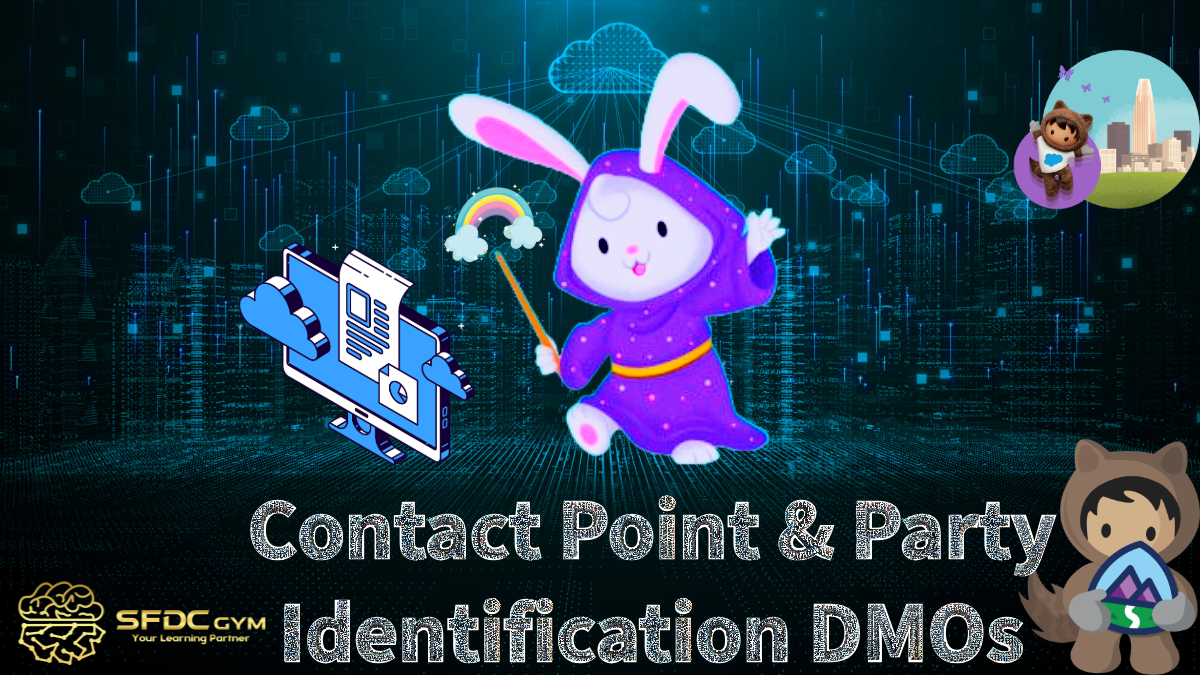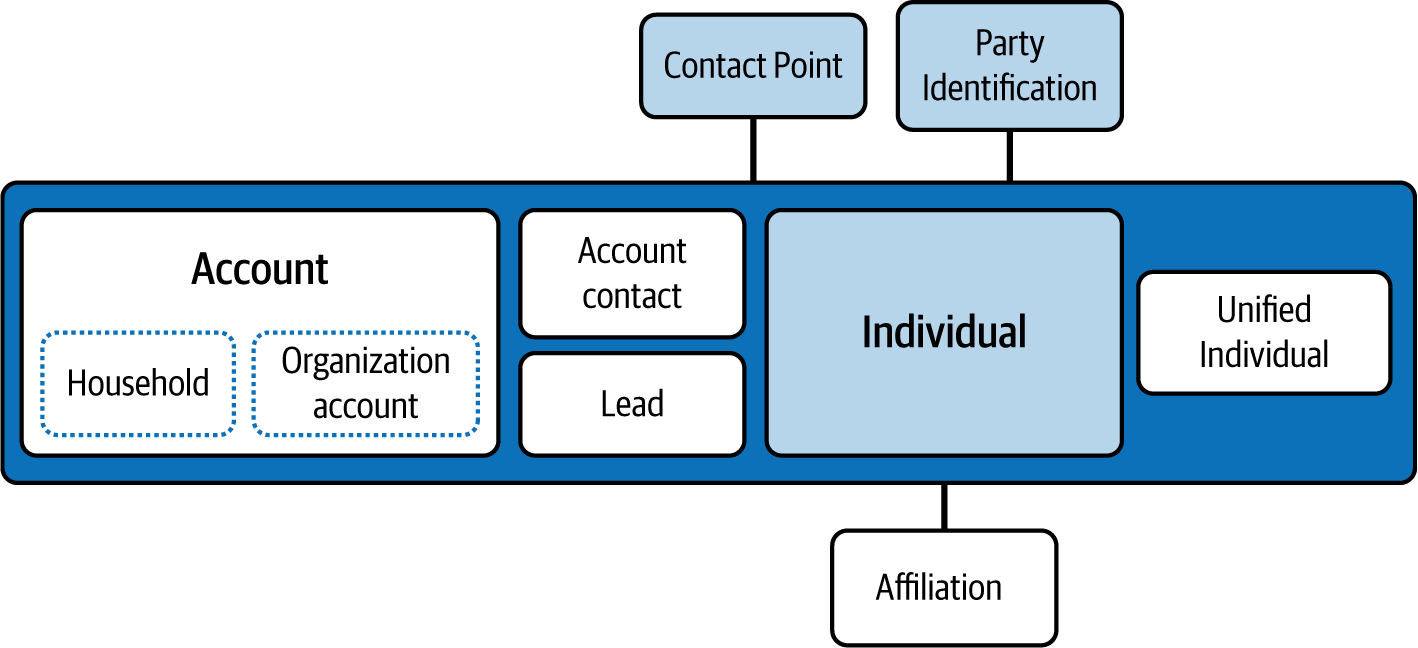Standard DMOs: Contact Point & Party Identification



Understanding Data Cloud and the Role of Standard Data Model Objects (DMOs)
Salesforce Data Cloud has revolutionized the way enterprises manage and streamline their data. Whether you're a Data Cloud Engineer, Architect, or Developer, understanding Data Cloud's Standard Data Model Objects (DMOs) like Contact Points, Unified Individuals, and others is crucial for efficient data mapping and business benefit.
Have you wondered why Data Cloud splits information into multiple DMOs instead of using Salesforce Core’s structure? Or how businesses unify customers’ data across multiple platforms? This guide addresses these questions and explores how DMOs like Contact Point and Party work as the building blocks of a sophisticated data ecosystem.
Why Does Data Cloud Use Multiple DMOs?
To understand the need for DMOs, let's use a simple analogy. Consider Salesforce Core as your personal bookshelf. When you need a math book, you open the shelf and pick it out—it’s simple and efficient for small-scale tasks. Now, think of Data Cloud as an entire library. If you're the librarian (the Data Cloud Engineer), your task is to organize various math books (data) into proper sections based on class, author, edition, etc. This categorization ensures that anyone can easily find the right book (relevant data) without rummaging through irrelevant sections.
The library model helps when we deal with large-scale enterprise data. With Data Cloud, splitting information into specialized DMOs:
- Creates a clear and scalable data structure.
- Makes it faster to retrieve specific data.
- Reduces duplication and improves data integrity.
By designing data storage like a library, Data Cloud enables better data handling, analysis, and sharing among business applications—ultimately empowering a company to serve its customers better.
Mapping Data Using Standard DMOs in Data Cloud
Data Cloud provides access to over 650 standard DMOs, each designed to address common business needs and streamline data management. These predefined DMOs simplify the process of organizing and integrating data by offering an established structure for various types of information. When ingesting data into Data Cloud, it is essential to map the incoming data to these standard DMOs wherever possible. This practice ensures consistency, reduces redundancy, and enhances interoperability across systems.
Before creating custom DMOs, it is highly recommended to explore the available standard DMOs to determine if they meet your requirements. Leveraging standard DMOs not only saves time but also aligns your data processes with best practices. Below, we’ll explore key DMOs used in this process.

Contact Point DMOs
Contact Point DMOs manage the various ways customers interact with a brand. Consider these as separate "contact sections" in your library where all communication methods are stored neatly.
Types of Contact Point DMOs:
- Contact Point Address (Postal addresses of customers).
- Contact Point App (Interaction via mobile apps).
- Contact Point Consent (Consent information for communications).
- Contact Point Email (Customer email details and interactions).
- Contact Point OTT Service (Over-the-top media services like streaming platforms).
- Contact Point Phone (Phone numbers used for communication).
- Contact Point Social (Social media contact points like Twitter and Instagram handles).
Each Contact Point category creates an efficient structure for storing diverse interaction details across channels. This separation enhances customer engagement and ensures data completeness for business applications.
Party DMOs
Party DMOs are focused on identifying the customer or entity. They help establish relationships, track activities, and manage comprehensive records of individuals.
Key Party DMO Components:
- Party (The base object representing a customer or business entity).
- Party Consent (Stores customer preferences regarding privacy and consent).
- Party Financial Asset and Liability (Holds information on assets and liabilities for financial customers).
- Party Identification (Identity-related information like IDs, passports, and tax documents).
- Party Role and Party Role Type (Defines a customer's role, like "buyer," "subscriber," or "member").
Party DMOs ensure businesses can identify individuals accurately while keeping all regulatory and compliance norms in mind. This increases trust and operational efficiency.
Individual
The Individual DMO plays a vital role in unifying disparate customer data. Once Amy’s contact points (email, phone, etc.) are mapped, and identity rules applied through Party DMOs, the Individual DMO consolidates everything into a single customer view. This is how businesses achieve their goal of personalization while avoiding redundancies.
Imagine a customer, Amy, interacting with different divisions of the Tata Group. She books a flight with Air India, providing her information as "Amy" with the email amy@gmail.com. Later, she books a hotel through Taj Hotels with "Amy Sosa" and the email amy.sosa@office.com. Lastly, she purchases a product from Tanishq, also part of the Tata Group.
Without Data Cloud, each division's system would treat Amy as a separate individual. This decentralized view could result in missed opportunities—like personalized marketing—or even inconsistencies, such as offering her competing advertisements.
Data Cloud resolves this challenge by unifying Amy’s data across all three divisions to create a "Unified Individual" profile. Through DMOs, data from various systems gets mapped, verified, and consolidated to provide a unified 360-degree view. This seamless integration achieves:
- Better personalization for customers.
- Enhanced marketing outcomes for businesses.
- Streamlined data for analytics and reporting.
Account Contact
While Party focuses on individuals, the Account Contact DMO emphasizes businesses and how they interact with their contacts. This is especially useful for B2B models where companies need to manage relationships with multiple stakeholders.
Lead
The Lead DMO plays a fundamental role in tracking prospects. When Amy expresses interest in Tata Group services for the first time, her data enters the Lead object. This allows sales teams to track, nurture, and eventually convert Amy into a loyal customer.
Affiliation
Lastly, the Affiliation DMO records relationships between parties—such as Amy being a frequent flyer with Air India, a valued guest at Taj Hotels, and a regular shopper at Tanishq. Strong affiliation entries make cross-brand partnerships and synergy opportunities seamless for businesses.
Leveraging DMOs to Create Business Value
By adopting Data Cloud’s approach to mapping data through DMOs, businesses can:
- Ensure clean, consistent, and accessible data across massive datasets.
- Craft unified customer insights for better decision-making.
- Build trust and loyalty by personalizing customer engagements.
For professionals working in Data Cloud environments, mastering these DMOs is essential to optimizing operations and driving business growth.


